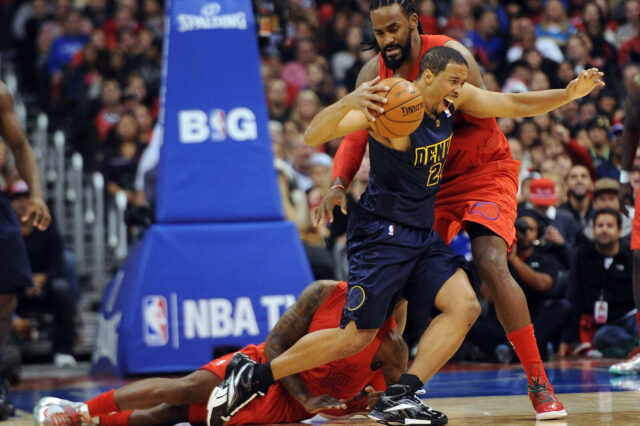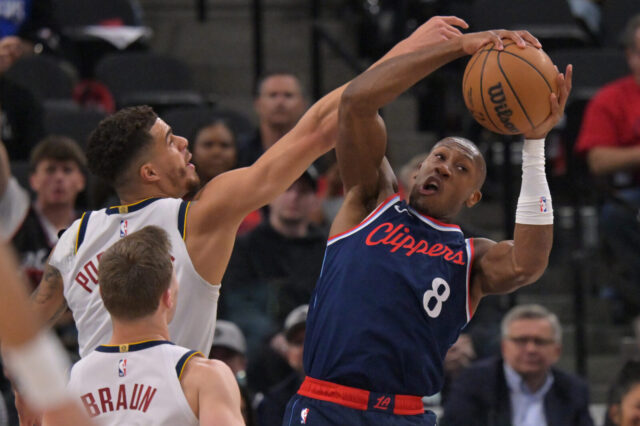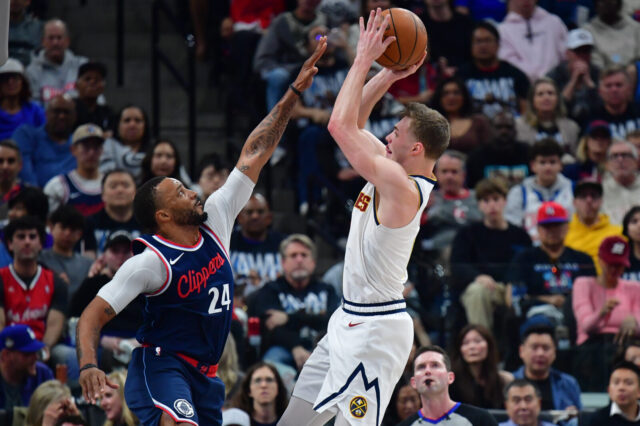Lots of interesting things happened in Saturday night’s road win over the Cleveland Cavaliers so I decided to make a notebook style list of things I found interesting.
Beating the trap
Trapping the ball-handler when Nikola Jokic is on the floor should spell suicide for opposing teams. If Denver’s guards can get the ball out of the trap, Jokic has a four-on-three attacking the basket and he is as good as anyone in the league in those situations. Unfortunately, for much of the third quarter against the Cavaliers, Jamal Murray and the Nuggets either failed to make the pass to Jokic on the roll or made the pass far too late to create an advantage.
Teams shouldn’t trap Denver. It plays right into their hands. Watch how easily Denver scores when they are able to pass out of the trap. That initial pass to the roll man is often what kick starts the fast passing attack that has become synonymous with Nuggets basketball over the last two seasons.
The Nuggets were able to close out the game because of their ability to beat these traps. Will Barton got the nod to close over Murray in part because Barton was doing a much better job of reading the court in the pick-and-roll (PnR). Watch how many of Denver’s points in the final minutes came out of making the simple play once Cleveland extended above the three-point line to trap the ball.
Problematic post ups
One other habit that derails Denver’s pass-happy offense is bigs spending too much time trying to post up. Paul Millsap is a really good post player and should hunt for opportunities to attack from the post but he’ll have to really pick his spots carefully in order to not mess with the offensive flow. This will be especially true when he shares the court with Denver’s premiere lineups featuring Jokic, Harris, Murray, and Will Barton. Lineups featuring those four guys have a 121 ORTG on the season, an absolutely scorching mark. Elite post-up players score somewhere around 1 point per post up (100 ORTG) and Paul Millsap is scoring 0.73 points per post up (73 ORTG). In short, the isolation post up is one of the team’s worst options.
That doesn’t mean Millsap shouldn’t ever try to go to work on the block, especially when he gets a smaller defender switched onto him. However, over the last few games, too many possessions have looked like the ones below, with everyone standing around and watching as Millsap fights for position on the block only to watch the shot clock wind down. In the first clip, Millsap had a wide open lane to roll for the easy dunk but elects instead to slow things down so he can post up Jordan Clarkson. In the second clip, Millsap gets the mismatch in transition but the team slows down to exploit that mismatch through a very slow, deliberate post up.
Similar things happen when Mason Plumlee is on the court. In the first clip before, he walls off the paint twice trying to post up the undersized Cedi Osman. In the second clip, he has no such advantage but still gets in the way of Barton who had his man beat off of the dribble.
Post ups can be a great way to collapse the defense or exploit a mismatch but they can’t come at the expense of ball movement and spacing. Post ups clog the paint so spending 10 seconds trying to gain or hold position often results in 10 seconds wasted off of the clock. This is one of those things that Jokic reads so well on offense. He often gets a mouse in the house but doesn’t waste too much time trying to hold position if the offense is moving nicely. An offense committed to ball movement and balance will exploit mismatches naturally, often in the form of offensive rebounds or quick-entry post ups in the natural flow of the offense. In the clip below, watch how quickly Jokic moves on to a pick-and-roll when the guards are unable to get him the ball inside. Some might call this Jokic being passive. I think it’s just smart basketball and trusting your teammates.
An even better example of a quick read out of a failed post up is the one below in which Chandler gets great position against a smaller defender but sees that Millsap elects instead to attack the basket off of the dribble. Chandler immediately reads the drive and clears the paint to make room for Millsap to operate. When Chandler’s man stays in the paint to block off the Millsap drive, Chandler receives the kickout pass and knocks down the shot. These are the types of quick reads that Chandler makes all of the time and they often go unnoticed by casual fans. The play doesn’t always result in him knocking down a three but awareness like this can be the difference between a teammate getting an open drive at the rim or a contested drive into traffic.
Wilson Chandler lobs
I loved this play between Chandler and Plumlee. First, Plumlee does a great job of walking the undersized Clarkson up into the middle of the paint before calling for the lob over the top. He’s essentially suckering Clarkson into fronting him in order top open up space for the lob over the top. Chandler reads it the whole way and throws the pass at the perfect moment when Clarkson has no chance of contesting it. Wilson is very good at this pass and actually throws it somewhat frequently, perhaps because he is also good at setting up undersized defenders this same way.
Cut and replace
A few weeks ago I showed a few basic principles of read and react basketball using a double pindown action as the example of how players can read and react to the defense and each other. One other important principle of free-flowing offense is how to cut and replace. The play below provides a good example of the basic principles. The action is a basic four-out post up – four players around the perimeter with one guy posting up on the block. It wasn’t a scripted play or anything but there are still a lot of options for the four players spacing the floor behind the arc.
Imagine there are four spots around the arc, one on each wing, one on the top of the key, and another in the opposite corner (the opposite short corner can replace the corner for non-shooting bigs). After Barton throws the entry pass, he has two options. He can cut right through or set a cross screen for the player at the top of the key. If he cuts through, he will finish his cut by running all the way to either the short corner or the opposite corner as the other three guys replace the open spots on the court.
This content is no longer available.
Barton instead elects to set a sort of split screen for Richard Jefferson. Here, Jefferson has two options. He can accept the screen and occupy the ball side wing or he can short cut the screen and cut down the center of the paint and continue his cut into the short corner or corner. He chooses option two and Barton reacts by replacing the open spot on the court, his own spot on the strong side which he just left. It’s simple enough but it’s one of a million little reads a team can make without calling a play. Everyone just knows when the ball goes into the post, it’s time to cut and replace.
DHO and cut and replace
To demonstrate how these cut and replace principles apply to actions besides just post entry, watch how guys cut (or drive) and replace in this free-flowing possession. First there is an early offense dribble handoff (DHO) between Jokic and Murray. Murray doesn’t find an angle to the basket so he kicks it out to Chandler who quickly gets it back to Jokic. Chandler then cuts, just like in the example above, and kicks off a cut and replace situation. Murray fills his spot, Millsap fills Murray’s spot, and Chandler fills Millsap’s spot in the dunker. Those little movements keep the defense occupied just enough to keep them from rotating over to stop the ensuing Jokic-Harris DHO which results in a Harris floater. Read and react basketball is beautiful.
Plumlee directing traffic
I really enjoyed this play from Plumlee. He sees the play developing two steps ahead and sees that after the initial pick-and-roll, he’ll go right into a DHO on the left side of the court. Knowing that Barton is in the corner, he directs Jefferson to cut through early so that the DHO will occur with Barton rather than Jefferson. It was a smart read and one of three straight buckets he and Barton got out of this action.
That example acts as a good blueprint for how Jokic should handle DHO situations with Millsap. When Millsap is on the court, Jokic often finds himself running at Millsap only to realize it is a wasted DHO since the defense either switches or goes deep under the handoff. In the example below, Jokic should do what Plumlee did and direct Millsap to cut through to the opposite side, opening up a perfect DHO with Harris attacking the middle of the court.
These awkward interactions happen once or twice per game between Jokic and Millsap so Denver would be wise to come up with a go-to plan for when they find themselves dribbling at each other. Having Millsap cut through is probably the best option.
Chandler and Millsap swapping spots
Late in the 4th quarter against Cleveland, Denver pulled Millsap out onto the wing and had Chandler play in the dunker spot and it was so successful that they might want to go to this more frequently in games to come. Chandler is really good at playing that spot and often plays there when he slides over to power forward. There’s also a hidden benefit of placing Chandler there when both Jokic and Millsap are on the court and that is that it draws both bigs outside of the paint, away from where they are most effective as rim protectors.
Millsap is a career 33% three-point shooter and is shooting 34.8% this season. Chandler is a career 33.8% three-point shooter and is shooting 33% this season. In short, both guys are about equal in three-point accuracy so it isn’t sacrificing too much in terms of a spacing threat to have Millsap out on the wing. But with the opposing center guarding Jokic out on the perimeter as he runs DHOs and PnRs and the opposing power forward sticking to Millsap on the wing, teams get placed in unfamiliar situations where they are asked to rely on the rim protection of their small forwards.


